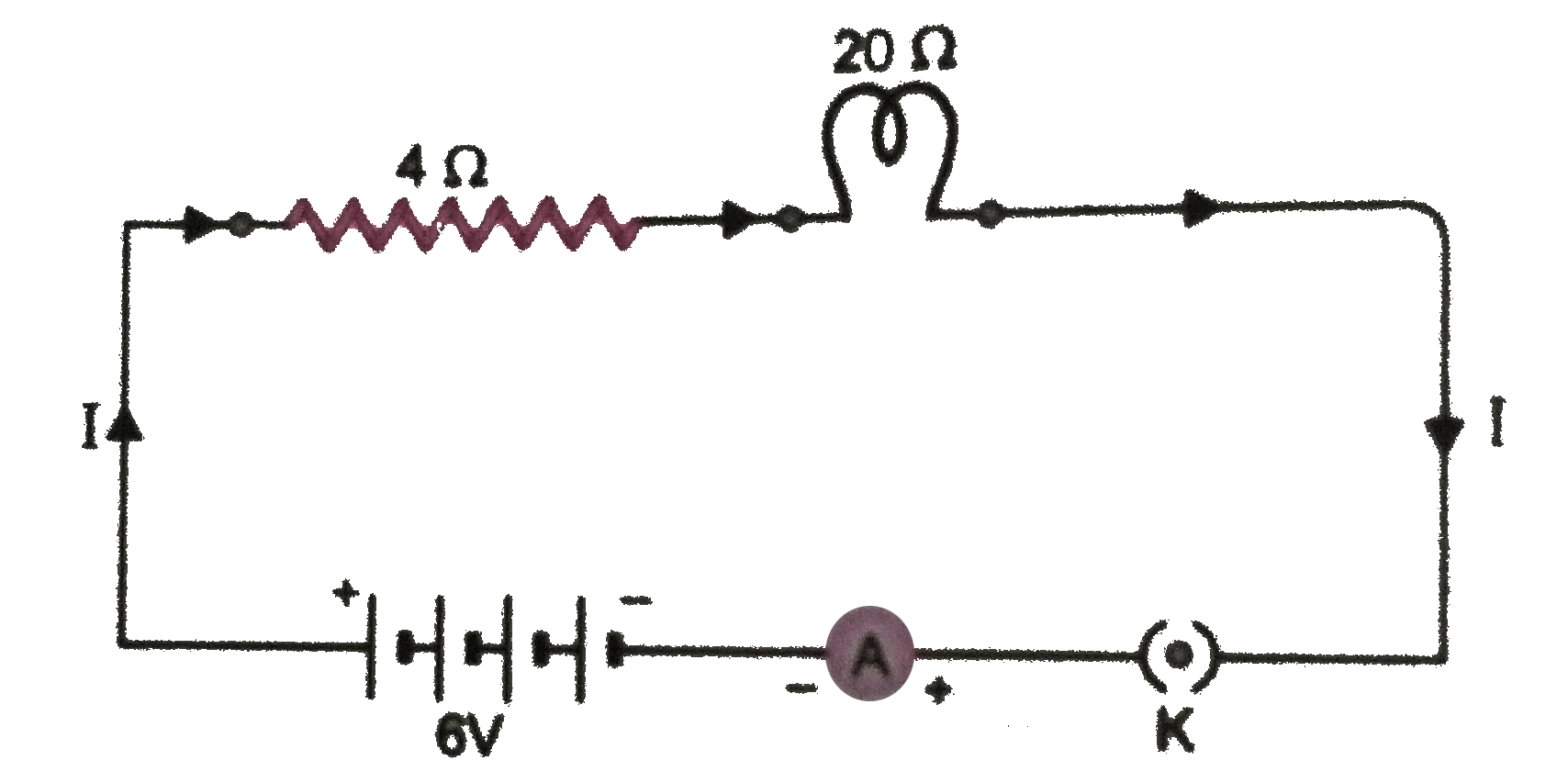A series circuit consists of three identical lamps connected to a battery as shown in Fig. 7.13.
when the switch S is closed, what happens
(a) to the intensities of lamps AandB,
(b) to the intensity of lamp C,
( c ) to the current in the circuit , and
(d) to the voltage drop across the three lamps ?
Does the power dissipated in the circuit increase, decrease, or remain the same ?

As the three bulbs are in series and identical , initially when switch S is open,
VA=VB=VC=13V
Also PA=PB=PC=(V/3)2R=V29R=P
Now , the swtch S is closed,
(a) The bulb C is short - circuited and hence potential difference across it is V'c=0 and so V'A=V'B=V2 with V'Cc=0. And hence,
P'A=P'B=(V/2)2R=V24R
i.e, P'A=P'(B)=94P,
i.e, P'A=P'B=94P,ltbegt i.e, intensities of bulbs AandB will increase and become 2.25 of their initial values.
(b) As V'c=0, no current will pass through bulb C , so it will give no light , i.e, P'c=0.
As RT changes from 3R→2R , so that current in the circuit will change from
I=V3R→I'=V2R,i.e,I'=32I
Thus , current in the circuit will increase and will become 1.5 times its initial value.
(d) As explained earlier , initially the voltage V divides equally across A,B,andC, i.e, VA=VB=VC=V/3. Now when the switch S is closed , bulb C is short - circuited , i.e, V'C=0 , so voltage V now will divide equally across AandB, i.e, V'A=V'B=V/2. So voltage across bulbs AandB will change from V/3→V/2, while across C from V/3 to zero, i.e, voltage drop across AandB will increase while across C it will decrease and becomes zero. Further as RT changes from 3R→2R, so power consumed in the circuit changes from
PT=V23R→P'T=V22R,i.e,P'T=32PT
Thus, power dissipated in the circuit increase and becomes 1.5 times its initial value.
Topper's Solved these Questions
- HEATING EFFECT OF CURRENTBOOK - CENGAGE PHYSICS ENGLISHCHAPTER - HEATING EFFECT OF CURRENTEXERCISE - Subjective
8 Videos
- HEATING EFFECT OF CURRENTBOOK - CENGAGE PHYSICS ENGLISHCHAPTER - HEATING EFFECT OF CURRENTEXERCISE - Single Correct
60 Videos
- HEATING EFFECT OF CURRENTBOOK - CENGAGE PHYSICS ENGLISHCHAPTER - HEATING EFFECT OF CURRENTEXERCISE - Solved Examples
13 Videos
- GEOMETRICAL OPTICSBOOK - CENGAGE PHYSICS ENGLISHCHAPTER - GEOMETRICAL OPTICSEXERCISE - Integer Type
4 Videos
- INDUCTANCEBOOK - CENGAGE PHYSICS ENGLISHCHAPTER - INDUCTANCEEXERCISE - Concept Based
8 Videos
Similar Questions
A circuit consists of three identical lamps connected to a battery as shown in the figure. When the switch S is closed then the intensities of lamps A and B

View SolutionA series circuit consists of three bulbs connected to a battery as shown. When switch S is closed, what happens to (a) Power consumed in bulb X and Y (b) Power consumed in bulb Z (c ) the current in the circuit (d) the voltage drop across three bulbs and (e) the power consumed in circuit?

View SolutionIn the circuit shown in fig. when the switch is closed, the capacitor charges with a time constant

View SolutionThree capacitors of capacitance C1=3μf,C2=6μfandC3=10μf, are connected to a 10V battery as shown in Figure 3 below

Calculate:
Equivalent capacitance
View SolutionFigure shows three idenetical bulbs A,B and C connected to a battery of supply voltage V. When the switch S is closed, discuss the change is .

(a) The illumination of the three bulbs
(b) The power dissipated in the circuit .
View SolutionThree capacitors each of capacitance C=2μF are connected with a battery of emf 30 V as shown in the figure . When the switch S is closed , the heat generated in the circuit will be

View SolutionThree identical bulb are connected as shown in figure . When switch S is closed, the power consumed in bulb B is P . What will be the power consumed by the same bulb when switch S is opened ?

View SolutionAn electric lamp, whose resistance is 20Ω and a conductor of 4Ω resistance are connected to a 6V battery as shown in (Fig. 3.18) Calculate.
(a) the total resistance of the circuit,
(b) the current through the circuit, and
( c) the potential difference across the electric lamp and the conductor.
 .
.
View SolutionHow should the several electric lamps be connected with the mains so that the switching on or off a lamp has no effect on the operation of other lamps ?
View SolutionAn electric lamp of resistance 2Ω and a conductor of resistance 4Ωare connected to a
6V Battery as shown in the circuit. Calculate:
(a) the totak resistance of the circuit,
(b) the current through the circuit,
(c) the potential difference across the (i) electric lamp
and (ii) conductor, and
(d) power of the lamp.

View Solution
